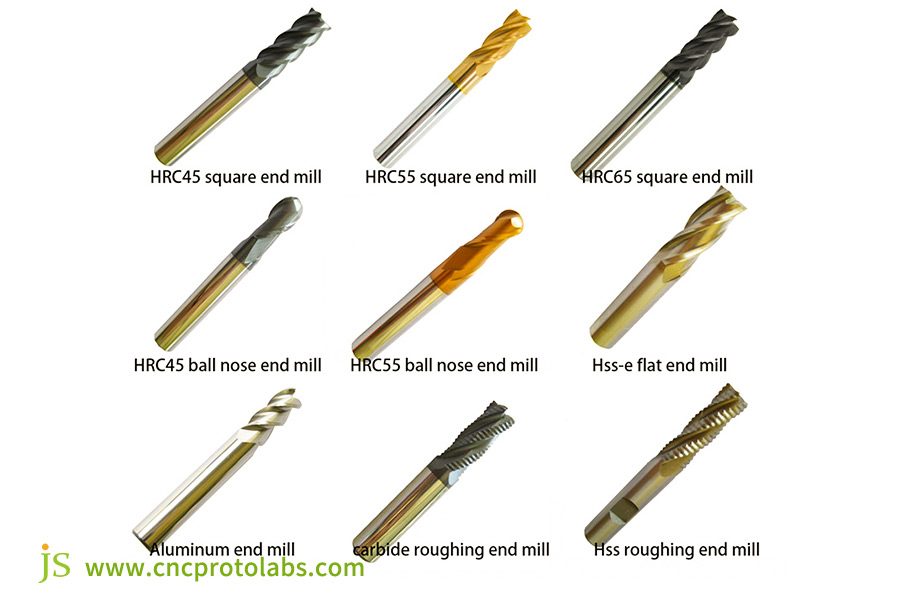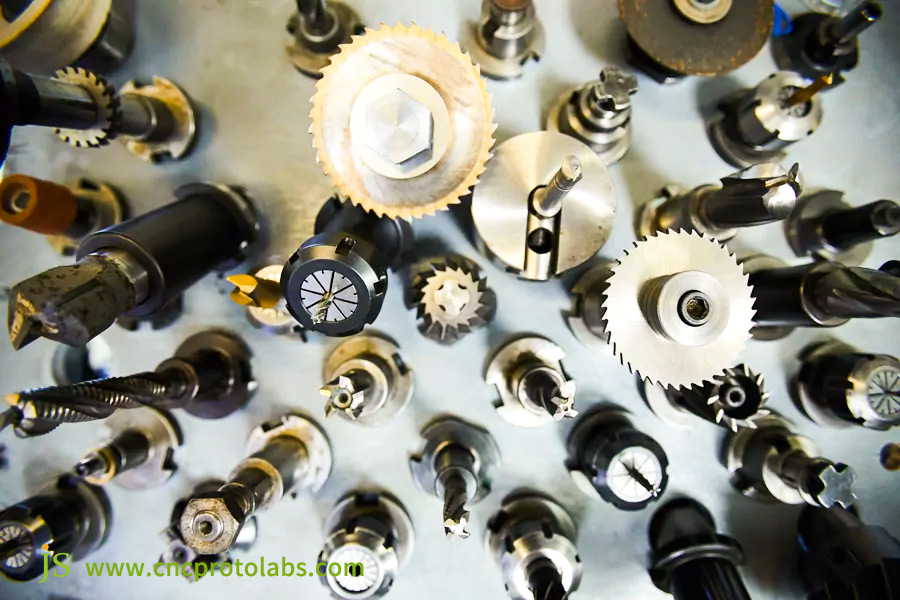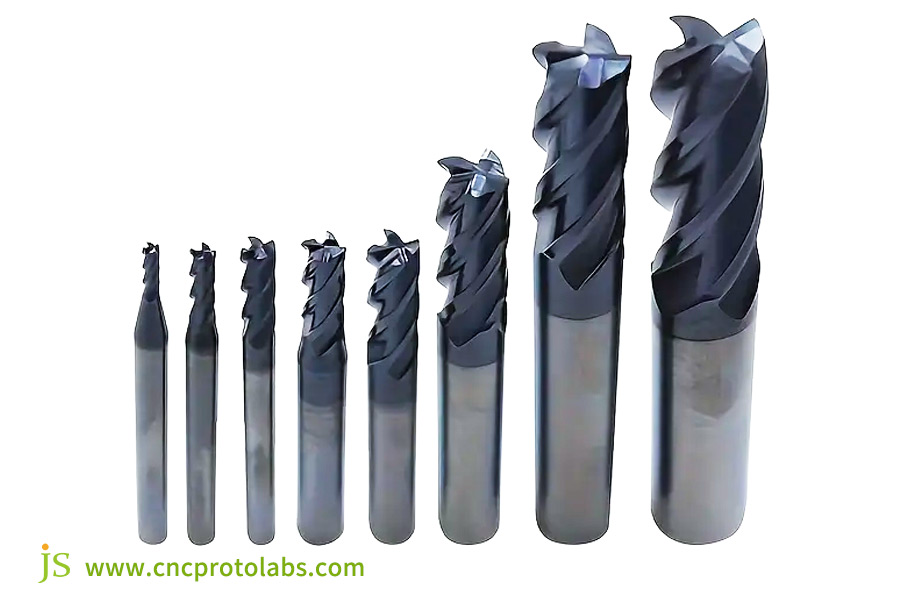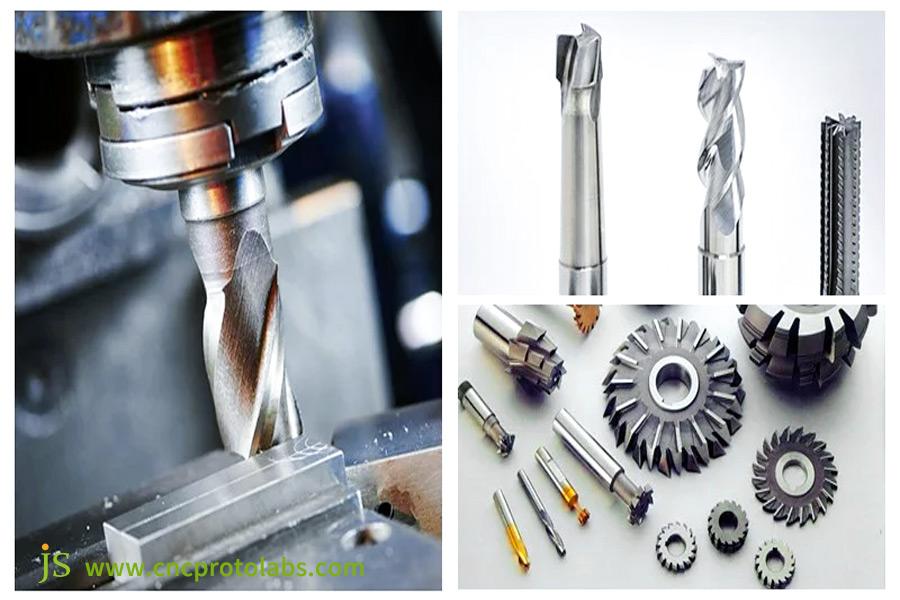In CNC machining, have you ever found yourself confronted with the following problems: chatter marks on a completed surface, like imperfections on a masterpiece, premature tool failure at a critical moment, leading to production downtime and added expense, or setting parameters confidently only to end up with an poorly finished workpiece?
These seemingly unrelated issues generally share the same root: improper selection of CNC mill machines. As the old adage teaches us, "If you want to do your job well, you must first sharpen your tools." A properly selected milling cutter for the specific job is the key to productive, quality machining.
This article, JS Precision's years of experience in a nutshell, will guide you through the process of choosing the right milling cutter and cure your machining headache.
Core Answer Summary
| Comparison Dimensions | Roughing Milling Cutter(The Workhorse) | Finishing Milling Cutter (The Artist) |
| Core Mission | Remove material economically and rapidly. | Obtain high-precision and smooth surfaces. |
| Geometric Features | Fewer teeth, greater chip space, and a stronger core. | Taller teeth, greater cutting edges, and a more accurate structure. |
| Application Parameters | High cutting depth, high feed, and high metal removal rate. | Low cutting depth, low feed, and high speed. |
| Material Considerations | The first consideration is toughness and impact resistance. | Hardness and wear resistance are the first consideration. |
| End Results | The first consideration is efficiency, and the second is the surface finish. | The first consideration is quality, and the quest is for optimal dimensions and finish. |
What's The Way To Choose A Milling Cutter? JS Precision Milling Cutter Choosing Experience
JS Precision has over 15 years of engineering experience in CNC milling and has processed more than 800 customers from 12 industries, such as aerospace, medical, and automobile, with CNC mill part processing and choosing milling cutters.
We have completed over 200 orders of materials machining. For example, we helped an airplane parts manufacturer achieve a 35% improvement in the efficiency of milling titanium alloy parts. We also solved aluminum alloy tool sticking issues for an electronics company, reducing scrap rates from 12% to 3%.
We also extended milling cutter life from 2 hours to 5 hours for a customer manufacturing 316 stainless steel medical parts in large quantities by improving flutes and coatings and reducing tool change downtime by 60% in direct terms.
This is not theoretical advice but a practical solution that our team came up with through experimental debugging and tuning of CNC mills. Whether you have efficiency bottlenecks in mass production or quality problems of small batches of precision components, you will be able to find the most suitable milling cutter for your CNC mill in this guidebook.
This professional ability has also received attention from TechBullion, who mentioned in their report our technological accumulation and industry service experience in the field of precision manufacturing.
JS Precision can provide specialized milling cutter solutions based on your processing materials and CNC mill parameters. We can provide you with a selection report within 24 hours of receiving your inquiry, and begin production immediately after confirmation of the solution, in an effort to allow you to quickly resolve the pain points of machining CNC mill parts.
Milling Cutter: The Core Cutting Component Of CNC Machining Tools
The milling cutter is the most crucial cutting element of CNC machine tools and the key to guaranteeing accurate milling of CNC mills. It is succinctly defined: a rotary multi-edge cutting tool which is the "executing terminal" of a CNC machining center, producing the workpiece by cutting. It is the link between digital design and physical finished product.
A correct milling cutter has a direct influence on three aspects:
- Processing efficiency: Metal removal rate. An excellent milling cutter, for example, can make aluminum machining more than 20% more efficient.
- Finished product quality: Accuracy of dimensions, accuracy of form, and surface finish, with an accuracy of ±0.005mm.
- Production cost: Tool life, tool-changing time, and scrap rate. A superior cutter can reduce tool changes by 30%.
In short, milling cutters are a critical link of the manufacturing process wherein "a slight difference can mean a tremendous error."
JS Precision is expert in custom CNC mill manufacturing. Be it machining steel, aluminum, or titanium alloy CNC mill parts, we have a suitable milling cutter solution to help you realize process stability and end-product quality improvement.
Core Methodology: 5 Golden Steps To Choose The Right Milling Cutter
No blind attempt is required in choosing a milling cutter. Follow these 5 steps to choose the proper one. These 5 steps encompass comprehensively all the aspects of milling cutter choice, ranging from the most basic requirements to deep optimizations.
Step 1: Inspect the Workpiece - Start with Material Properties
Start with the workpiece material (steel, aluminum, titanium alloy, composite material, etc.), hardness, and heat treatment condition. It is the simplest rule in selecting a milling cutter. The tool material for various materials varies greatly. It is a brief comparison table of standard materials and tool materials:
| Working Material | Recommended Tool Material | Application |
| Steel, Cast Iron (Hardness ≤ 30 HRC) | High-Speed Steel (HSS) | General roughing, low-cost operations. |
| Steel, Cast Iron (Hardness > 30 HRC) | Carbide (WC-Co) | Medium-to-high-speed machining, high wear resistance operations. |
| Aluminum Alloys, Non-Ferrous Metals | Ultra-Fine Grain Carbide | Anti-Stick Cutting, high surface quality operations. |
| Titanium Alloys, High-Temperature Alloys | Cermets, CBN | Heat Resistance, work-hardening resistance operations. |
| Composites, Plastics | Diamond-Coated Tools | Fiber-Tear Resistance, high precision operations. |
Step 2: Identify the Task - Roughing, Finishing, or Specialty Machining?
Choose initial tool type by machining operation:
- To rough (high material removal rate), employ end mills or face mills. They have big chip pockets and remove metal by cutting away at high speed.
- To finish or near-contour, employ ball-end mills or bullnose mills. They have sharper cutting edges and leave smoother surface.
- Utilize forming mills or T-type mills used for specific machining forms for unusual machining requirements (such as engraving or grooving).
Step 3: Check the Machine Tool - The Equipment is the "Ceiling."
Checking the power, rigidity, maximum speed, and clamping system (BT, HSK, etc.) of the CNC mill. For example, a CNC mill with power less than 5kW is not suitable for big milling cutters above 20mm in diameter.Otherwise, the milling will be "overwhelming," resulting in vibration and decreased accuracy.
In case of utilizing an ER collet as the clamping system, ensure the runout is ≤0.005mm not to compromise the accuracy of the milling cutter.
Step 4: Lock in Parameters—Diameter, Number of Flutes, Flute Length, and Geometry
- Diameter: Choose based on nature of workpiece and size of the cavity. For example, for a 10mm deep hole, an 8-12mm diameter milling cutter would be best.
- Number of Flutes: Multi-flute milling cutters (4-6 flutes) would be best for hard materials like steel and cast iron for better wear resistance. Less-flute milling cutters (2-3 flutes) would be best for non-ferrous metals and aluminum for simple chip removal.
- Geometry: 30°-45° helix angle in general machining, 10°-15° rake angle for soft materials, and 8°-12° clearance angle reduces friction between workpiece and tool.
Step 5: Final Selection—Coating and Brand Price-Effectiveness
Common Coatings and Uses:
- TiN Coating: General-purpose and most suitable for steel and aluminum machining. Cheap, priced at approximately $50-80 per cutter.
- Colored TiAlN Coating: Highly temperature-resistant, for high speed and hard material machining. Priced around $80-120 US.
- TiCN coating: Highly wear-resistant, for cast iron machining, priced around $70-100.
In choosing a milling cutter, balance cost versus performance. For example, in batch machining, the TiAlN-coated milling cutter is costlier per piece, but it lasts longer and costs less overall.
JS Precision online CNC mill service can suggest the most suitable milling cutter for your material, CNC mill specifications, and machining requirements in these five easy steps. Risk-free selection is also possible with free trial cutters.

Avoid These Mistakes: 5 Often Overlooked Mistakes In Selecting A Milling Cutter
In selecting a milling cutter, the following five seemingly trivial mistakes can cause huge losses and must be avoided:
1. Disregarding Chip Evacuation? Chips wrapping around the cutter, scratching the machined surface, and even chipping the tool are caused by poor chip design. For example, during turning aluminum alloys, if the chip pocket is inadequate, chips will stick to the cutting edge, resulting in burrs on the machined surface.
2. Chasing an "Universal Tool" Too Much? Trying to machine everything with a single milling cutter will cost you something. For example, finishing machining with a roughing milling cutter can reduce tool life by more than 50% and machining productivity.
3. Ignoring the accuracy of the toolholding system? Even the finest milling cutter will be ineffective if it's inserted into a collet with a runout of more than 0.01mm. So, it's essential to choose high-precision toolholders, such as shrink-fit chucks with a runout of 0.003mm or better, to get the best out of a milling cutter.
4. Distracted by the initial price and ignoring the unit cost? Don't think only of the piece price, but of the "cost per unit." A $100 milling cutter, for example, will produce 100 units, that is, $1 per unit. A $50 milling cutter produces only 30 units, that is, approximately $1.67 per unit—more expensive.
5. Overlooking coolant strategy? Dry cooling is suitable for machining aluminium and plastic, wet cooling for machining steel and cast iron, and oil mist cooling (MQL) for high-speed machining. The use of dry cooling in machining steel can decrease cutter life by over 60% and create a discoloration of the surface of the workpiece.

In-Depth Analysis: The Key Differences Between Roughing And Finishing Milling Cutters
The design criteria of roughing and finishing milling cutters are quite dissimilar. Mixing both can result in a catastrophic failure in machining performance. Below is a comparative summary of both:
| Comparison Dimensions | Roughing Milling Cutters | Fine Finishing Milling Cutters |
| Design Objectives | Achieve maximum material removal rate, eliminate material at a high rate. | Preserve surface quality and dimension accuracy. |
| Geometry | Stiff tip and heavy chip flute. Flutes 2-3 times diameter in average. | Multi-cutting edges (4-8 flutes) and sharp cutting edges. Edge finish Ra 0.4μm or finer. |
| Coating Options | Impact- and wear-resistant coatings (e.g., TiCN), 3-5μm thickness coating. | Low-friction, high-hardness coatings (e.g., TiAlN), 2-3μm thickness coating. |
| Application Techniques | Deep depth of cut (1-1.5 x diameter), large feed (0.1-0.3mm/r). | Shallow depth of cut (0.1-0.3 x diameter). Several), high speed (10,000-20,000 rpm), small stepover (0.1-0.2 mm). |
| Common Uses | Roughing out of workpiece blank and removal of unnecessary material. | Final finishing machining of workpiece to dimensional accuracy and surface finish. |
For example, for roughing 45 steel parts, the milling cutter 16mm diameter, 4-flute, TiCN-coated, cutting depth of 16mm diameter and feed rate of 0.2 mm/r is utilized, for finishing, a 6-flute, TiAlN-coated milling cutter with the same diameter and cutting depth of 3mm and feed rate of 0.1 mm/r is utilized. This serves to balance well between efficiency and quality.
JS Precision offers a complete range of roughing and finishing milling cutters and can be designed to tailor tool geometry to your specifications in CNC mill parts machining, every step closely integrated for accuracy.

Practical Review: What Did JS Precision Do To Achieve 40% Machining Improvement Of 316 Stainless Steel?
Background
One of the medical device manufacturers machined 316 stainless steel structural parts on a CNC mill. There were three primary problems with the initial process:
- There was excessive work hardening of the material. After the cutter had entered the workpiece, the surface hardness increased from 20HRC to 35HRC, and there was greater cutting resistance.
- Tool sticking was a regular occurrence, and chips would stick to the cutting edge, and there would be regular machine stops to clean it.
- Machining productivity was low. The milling cutter was renewed every two hours, and the one-piece machining time was 12 minutes. The CNC mill usage was only 60%.
JS Precision's Solution
JS Precision designed a general optimization plan to address the above problems:
1.Tool Selection: A 7-flute high-feed milling cutter with a sharp cutting edge and a new TiAlN-based nano-coating was selected. The coating has 20% greater heat resistance than traditional TiAlN, reducing tool sticking. The 12° rake-angle sharp cutting edge reduces cutting resistance and work hardening.
2.Strategy Modification: Implemented a high-feed milling (HFM) strategy from the beginning, rather than the original 5mm cutting depth and 0.6mm/r feed, shifting to a 3mm cutting depth and 1.2mm/r feed. This reduced tool-workpiece contact time and avoided work hardening.
3.Parameter Optimization: Increased the linear speed of the CNC mill from 80m/min to 110m/min and the feed per tooth from 0.15mm/z to 0.2mm/z. Another internal high-pressure coolant system was also activated, with a pressure of 10MPa, to facilitate real-time chip flushing and cutting edge temperature cooling.
Results
The optimization did remarkably well:
The time for single-piece machining came down from 12 minutes to 7.2 minutes, 40% efficiency gain, the milling cutter life improved from 2 hours to 5 hours, and the tool change idle time was reduced by 60%, the product surface roughness fell from Ra1.6μm to Ra0.8μm, and the dimension tolerance was maintained at ±0.008mm, fully meeting the requirements of medical components.
This situation demonstrates the integrity of the process from material analysis to tooling choice.

Decision Moment: Four Key Factors Impacting The Final Choice
The final step in selecting a milling cutter is to strike a balance between the subsequent four key factors based on your priority to arrive at the best solution:
1.Highest Priority: processing quality requirements.Parts for military and aerospace uses require extremely high accuracy (tolerances in the order ±0.003mm), where high-precision milling cutters such as diamond-coated cutters are required. For common civilian components (tolerances in the order ±0.05mm), standard carbide milling cutters are adequate.
2.Most Significant Factor: overall cost of production. In volume of production, consider "tool cost + machining time cost + scrap cost." For example, a customer with an order to produce aluminium parts in high quantities might pay $100 for a TiAlN-coated milling cutter. The unit is more costly, but the overall cost is 30% lower than with a $50 milling cutter.
3.Most Pressing Short-term Requirement: production lead time. For quick prototyping (lead time 1-3 days), an all-purpose milling cutter, e.g., a 45° square shoulder milling cutter, is necessary for quick processing. For large-scale production (lead time 1-2 weeks), specialist milling cutters designed to deliver lasting efficiency can be utilized.
4.Often Overlooked: machining stability and safety. If the CNC mill is not extremely rigid, a mild milling cutter has to be employed to prevent vibration. When machining deep-cavity parts, a milling cutter having a suitable aspect ratio (aspect ratio ≤ 5:1) should be selected to prevent tool breakage.
CNC mill prices at JS Precision will be transparent and explicit based on your needs for production cycle and machining quality so that you get the right ratio of quality, efficiency, and price with no room for additional charges.
Industry Outlook: Global Milling Tool Market Growth Forecasts And Future Trends
The global milling cutter market keeps expanding. The global milling tool market will post a compound annual growth rate of 5.2% from 2023 to 2028, according to authoritative research firm Gardner. CNC milling tools will have the greatest demand growth, and the market value will hit more than $8 billion by 2028. There are four trends:
1.Intelligence: Milling cutters with sensors will be connected to the Industrial Internet of Things (IIoT) and will capture cutting temperature, vibration, and other parameters in real time, with machining parameters being optimized automatically with minimum human involvement.
2.Tailoring: The industry is demanding increasingly specialized milling cutters for particular materials and components, including tailored milling cutters for new energy car battery cases and aircraft engine blades. These can raise machining efficiency more than 20%.
3.Material Innovation: Ultrafine-grained WC-Co alloys and diamond coating technology will be more common, increasing milling cutter life by 30%-50%, being suitable for hard-to-machine materials like high-temperature alloys and composites.
4.Green Manufacturing: Dry and minimal-quantity lubrication (MQL) machining are increasingly becoming standard, demanding greater demands on the high-temperature endurance and low-friction performance of milling cutters. Environmentally friendly coatings like TiAlN-SiN coatings will gain greater popularity.
Action Guide: Order Your Custom Milling Cutters Today
If choosing milling cutter is still hard, simply apply the following three steps to get your own solution. The process is simple and efficient:
1. Define Requirements: Determine your machining material (e.g., steel, aluminum, titanium alloy), your CNC mill's power and top speed, and your machining goals (e.g., accuracy requirements, batch size of production, and delivery schedule).
2. Enter Requirements: Provide JS Precision's technical experts or input your requirements through our selection system, saving time searching through technicalities.
3. Obtain a Solution: Within 24 hours, we will provide you with a complimentary, custom milling cutter selection report and test cutter recommendations. Upon acceptance of your solution, you can order and have your cutter delivered and be cutting within three days.
10. FAQs
Q1: Do I first purchase an improved machine tool or an improved cutting tools?
If the CNC mill's performance is already within standard, then it will be worthwhile to invest in a more quality milling cutter initially. More quality milling cutters directly improve machining quality, less scraps, longer tool life, and reduced tool changing time, which will be cheaper in the long run. Replacing machine tools requires 5-10 times more investment than purchasing more quality cutting tools, and its impact is slower to come.
Q2: When should I realize a milling cutter wears out and needs to be replaced?
Four areas must be monitored when looking for milling cutter wear: hear a heavy or sharp cutting sound, see chatter marks or burrs on the machined surface, see chip color or irregularity, and inspect flank wear at interval intervals. If flank wear is greater than 0.3mm, the cutter must be replaced to avoid decreasing machining quality.
Q3: Why is the difference in performance between domestically manufactured and imported milling cutters of the same parameters so huge?
The nature of the difference is in the details: Imported milling cutters have finer edge finish and angle tolerance, finer coating flatness and high-temperature oxidation resistance, more uniform base material composition and impact toughness, finer dynamic balancing accuracy, and lower vibration when spinning. All the details combine to bring about substantial differences in CNC mill part machining results.
Q4: What is the cheapest milling cutter configuration for small-lot and high-mix machining?
A milling cutter arrangement is suggested for high-variety and small-batch machining. First, it is suggested to mount a set of common-purpose carbide milling cutters. Second, choose 3-5 basic specifications to minimize the inventory cost. Third, select JS Precision's small-batch custom tooling services to drive low inventory holdings, and overall cost reduction.
11. Summary
Selecting the perfect milling cutter is a beautiful waltz between materials science, mechanical engineering, and economics. Gone are the days of the back-of-the-envelope estimate of experience, but now it is an exact science that one can learn using a scientific mindset. Mastering this science will realize the true potential of your CNC mill and convert every machining issue into an opportunity to highlight your skill.
As a professional custom CNC mill manufacturing service supplier, JS Precision offers one-stop service from the selection of milling cutters to machining of the CNC mill parts. From machining conventional or hard-to-machine materials, mass production or rapid prototyping, we offer cost-effective solutions.
You only need to describe your needs, and we are able to help you with anything from equipment selection and parameter setting to final processing so that your CNC processing is more stable and efficient. We are also offering free tool testing, which means you are able to work with us risk-free.
Disclaimer
The contents of this page are for informational purposes only.JS Precision Services,there are no representations or warranties, express or implied, as to the accuracy, completeness or validity of the information. It should not be inferred that a third-party supplier or manufacturer will provide performance parameters, geometric tolerances, specific design characteristics, material quality and type or workmanship through the JS Precision Network. It's the buyer's responsibility Require parts quotation Identify specific requirements for these sections.Please contact us for more information.
JS Precision Team
JS Precision is an industry-leading company, focus on custom manufacturing solutions. We have over 20 years of experience with over 5,000 customers, and we focus on high precisionCNC machining,Sheet metal manufacturing,3D printing,Injection molding,Metal stamping,and other one-stop manufacturing services.
Our factory is equipped with over 100 state-of-the-art 5-axis machining centers, ISO 9001:2015 certified. We provide fast, efficient and high-quality manufacturing solutions to customers in more than 150 countries around the world. Whether it is small volume production or large-scale customization, we can meet your needs with the fastest delivery within 24 hours. Choose JS Precision this means selection efficiency, quality and professionalism.
To learn more, visit our website:www.cncprotolabs.com






